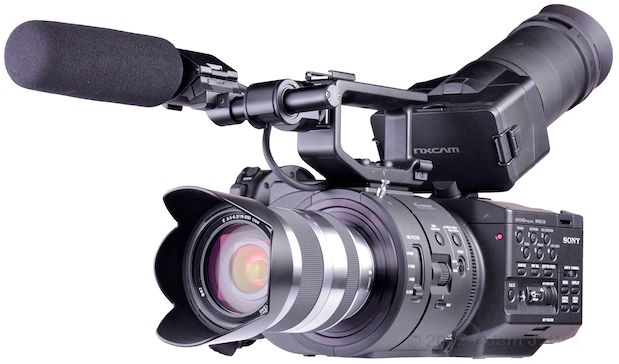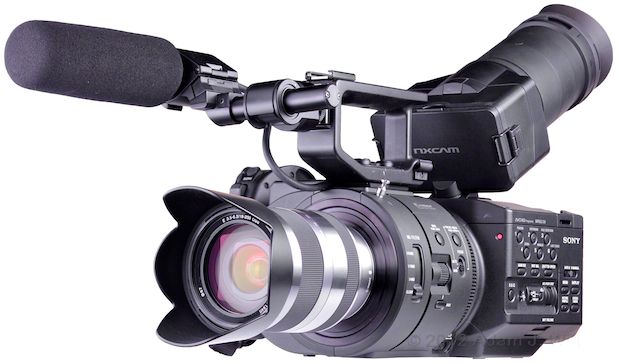
The NEX-FS700 (US$8000; $8600 with 18-200mm zoom lens) is an E-mount Large-Single-Sensor camcorder with the back end, user interface, and lens mount of the NEX-FS100, but with an entirely new camera section sandwiched between ’em. The FS700 still takes E-Mount lenses (and other lenses via adapters) and still records AVCHD clips to SDHC cards, Memory Sticks, and an optional 11-hour Flash Memory Unit, but those clips now come from a camera with ND filters, slow-motion options to 960fps, and up to 14 stops of dynamic range with highlight-friendly cine gamma rendering.
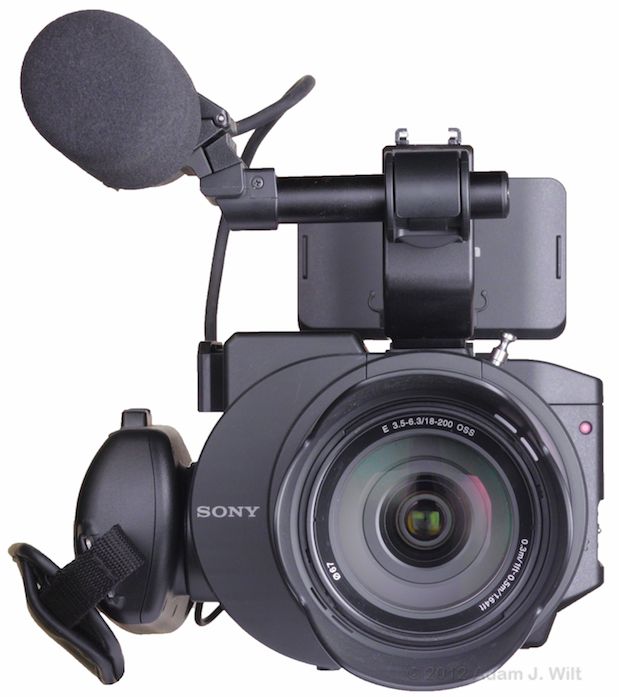
NEX-FS700 head-on.
I characterized the NEX-FS100 as “a short, stubby brick with a Dixie cup glued to one end”. The FS700 uses the same brick, but glues it to a comparatively massive, cylindrical camera section instead:

FS700 compared to FS100, from my Cine Gear Expo presentation.
The new camera weighs about a pound more than the older one: 6 lb 12 oz (1680 g) when in the shooting configuration seen above. The body itself is a couple of inches longer and about 3/8″ taller, all due to the larger front end and the thick baseplate beneath it, and 3/4″ wider, due to the offset ND filter wheel housing at the front of the camera.
What does this added bulk buy you over the FS100? The short list:
-
- Super Slo-Mo: 120 & 240fps at full res, 480fps with reduced vertical resolution; 960fps windowed down 2x with half the vertical res of 480fps.
-
- Three built-in ND filters.
-
- PMW-EX1/EX3/F3-style cine gammas (this is huge).
-
- HD-SDI output.
-
- A vastly-improved side grip.
-
- The possibility of some sort of 4K raw output (!) in the future.
Design
Left Side
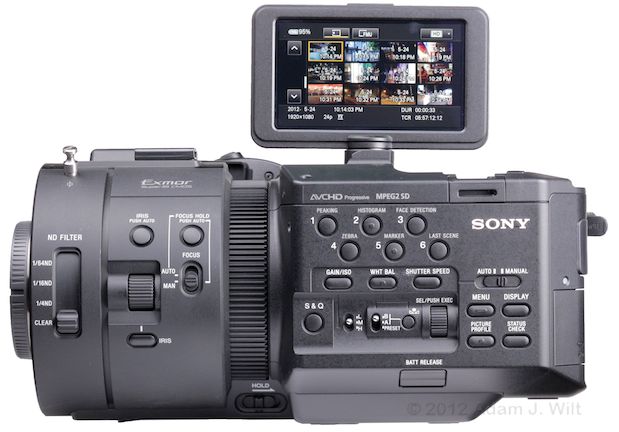
Left side: lens, exposure, and operational controls.
At the very front of the camera there’s a four-position slide switch for the built-in ND filters. Aft of that, there are iris controls (useful for E-mount lenses, Alpha-mount lenses on the LA-EA2 adapter, or Canon lenses on the Metabones adapter): a momentary PUSH AUTO button, a dial for manual iris selection, and an IRIS button to select auto or manual modes. Focus controls are provided (again, for E-mount or Alpha-mount lenses); a momentary pushbutton and a slide switch for auto/manual focus. The pushbutton provides autofocus in manual mode, and holds the current focus in autofocus mode, a nice touch.
There’s a big, ribbed metal ring coupling the camera section to the recorder section. It looks like the World’s Biggest Focus Gear, but it doesn’t turn; it appears to be a heatsink/radiator. At its base, nestled away from fumbling fingers, is a HOLD slide switch. It can be set to lock all the controls, everything other than record start/stop and PHOTO buttons, or everything aside from start/stop, PHOTO, and camera-mode controls.
On the recorder section there are two rows of three assignable buttons, labeled 1-6 in bright white. Default functions are shown in darker gray, and the defaults are mostly sensible, so you may not need to change them except in unusual conditions. The one probable exception is FACE DETECTION, an auto-face-finding focus mode only usable with E-mount (and possibly some Alpha-mount) lenses; if you’re not using a compatible lens, changing #3 to something more useful is easily done (I picked EXPANDED FOCUS for my tests, and was well pleased).
[Yes, the default buttons for ZEBRA and PEAKING are swapped compared to their placement on the FS100. The rationale behind the swap is a mystery. Shooters with both cameras can, of course, reprogram one camera to match the other, but relabeling the buttons with scraps of sticky tape is an inelegant solution to an inconsistency that shouldn’t exist in the first place.]
Three oblong buttons toggle manual control of gain, white balance, and shutter. Below these are a pushbutton to invoke S&Q (Slow and Quick, or variable-speed) recording, which can be set to S&Q, Super Slow Motion, or both; a three-position gain switch; a three-position white-balance switch (A/B/PRESET); a white-balance-setting pushbutton; and a multi-purpose thumbwheel. The thumbwheel sets shutter speeds, frame rates, auto-exposure adjustments, and traverses menus, depending on which button was last pressed.
Above the SONY logo there’s a slot for threading a carrying strap. Below the logo, a slide switch toggles the camera’s general operation between fully AUTO and selectable MANUAL controls. MENU displays the camera’s menus, while PICTURE PROFILE brings up a selection of six picture profiles (custom presets) letting you fine-tune image parameters like gamma, matrix, detail, and knee. A DISPLAY button toggles the data readouts on the LCD (and the output connections, if you’ve configured the camera to do so), while the STATUS CHECK button cycles through a set of LCD overlays with detailed information on the camera’s status and configuration.
At the very bottom there’s a push-in BATTery RELEASE button, and at the back, there’s a flip-open door for the MS/SDHC card slot, with a card-access LED above it. The LED glows red when the card is being written to or read from: a stoplight letting you know when it’s not safe to pop the card out.
Rear
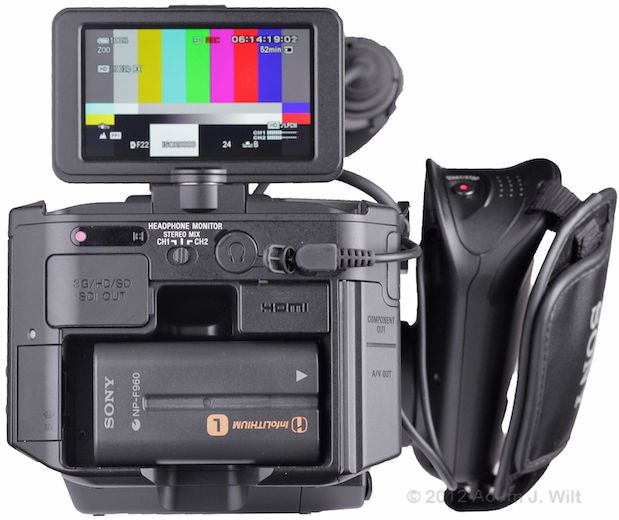
Rear view with LCD upright and side grip cable plugged in.
At the upper left there’s a narrow window for the IR remote control, with a tally-lamp LED embedded in it. A channel-selection switch for the headphones lets you choose Ch. 1, Ch. 2, or a stereo mix; it sits beside the 1/8″ / 3.5mm stereo headphone jack, which lurks behind a tethered rubber cap. Also on the same tether is a cap over the REMOTE jack, a LANC port compatible with the full-featured RM-1000BP controller, though more normally used for the handgrip’s control cable.
Just above the cavernous battery well, a 3G HD-SDI output replaces the FS100’s mike input 2, behind a flip-out rubber cap on the left. On the right, a flip-up door reveals a full-sized HDMI port.
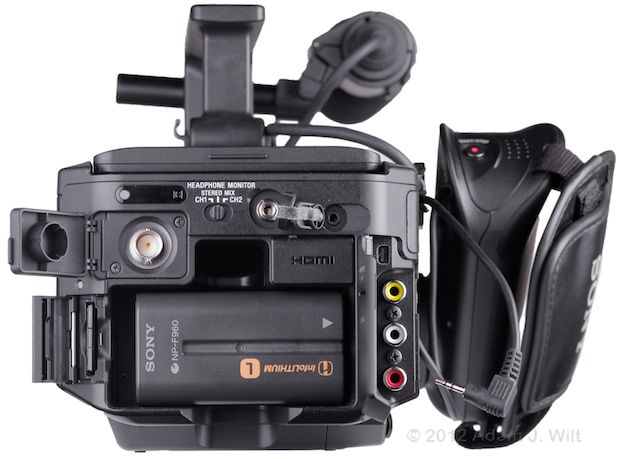
Rear view with LCD closed and most doors/caps open. Sorry ’bout the gaffer tape.
On the left, again, we see the card slot door; on the right another door hides RCAs for composite video and stereo audio output, as well as a Sony-proprietary D-shell jack for an analog component video cable, included, which terminates in three RCA plugs.
You’ll note that the mike holder appears to be sagging a bit. It’s unsightly, but not problematic; the mike holder (as we’ll see) can rotate a bit in its shoe mount, and the lateral arm can sag slightly as it’s carried in a rubber shock-absorbing sleeve.
Right Side
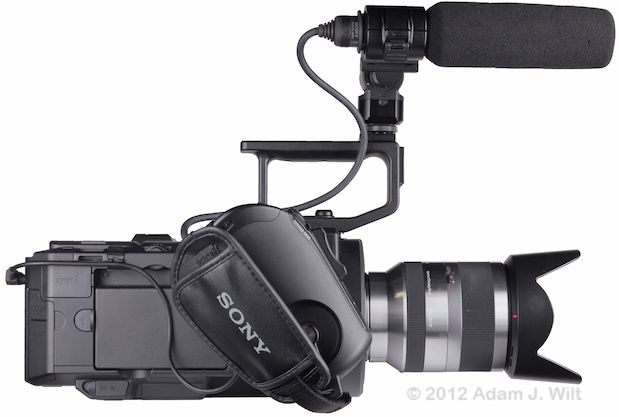
Right side view with mike holder in top shoe mount.
The right side has another carrying-strap lug, and a cable clip for wrangling the cables from the included microphone and the removable handgrip. XLR input 1 has its own rubber cover, as does the USB port below it. The rotating handgrip attaches up front on an Arri-style rosette. At the bottom rear there’s a DC power port behind another flip-open rubber cover.
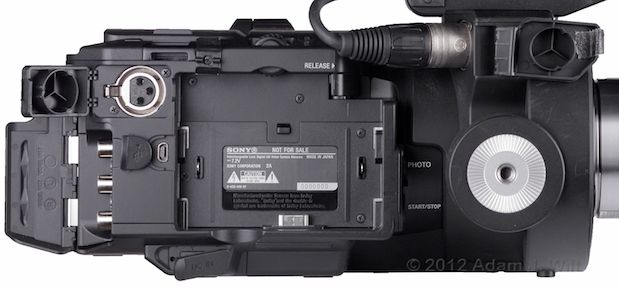
Right side, grip removed and port covers open or removed. Sorry ’bout the gaffer tape.
The bulk of the right side is occupied by a pop-out blank. Flip its release lever forwards and pop the blank out, and you can pop in the same HXR-FMU128 memory unit used on the HXR-NX5 and on the FS100.
XLR Input 2 sits just inboard of the handgrip mount. The front of the recorder has two pushbuttons, a PHOTO trigger and a START/STOP trigger. They’re somewhat hard to locate by touch with the grip removed, and well-nigh impossible to get to with the grip in place—but as they’re replicated on the handgrip itself, that’s not really an issue.
Top
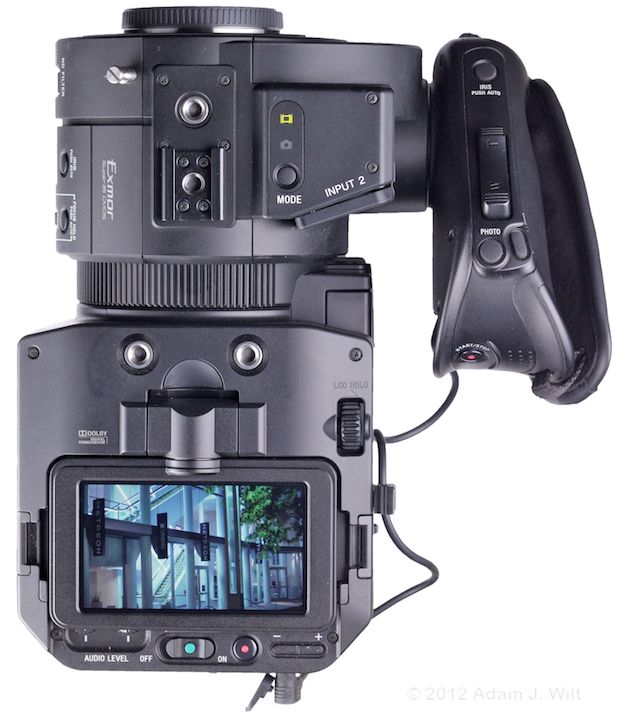
Top view: the LCD can be flipped around and folded flat for top-down viewing.
It’s clear from this view how far off to the side the handgrip is; it’s pushed out to the right by the need to clear the offset filter wheel housing.
The top of the camera has two 1/4″ mounting sockets up front and two just ahead of the LCD; these provide secure attachment points for (a) the supplied carrying handle or (b) third-party top mounts and cheese plates. Because the front half of the camera is both longer and taller than the corresponding part of the NEX-FS100, existing FS100 bolt-ons won’t work, but rest assured folks like Solid Camera and Shooting Machine are developing FS700-specific accessories as I write this.
The camera’s LCD sits amidships on a tilt-and-swivel mount. A thumbwheel to its right adjusts tilt friction, necessary when using the long and heavy viewfinder tube.
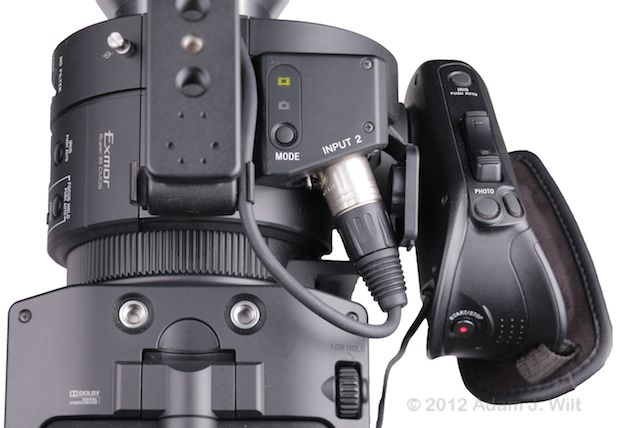
Top front: focus hook, mode selector, input 2, and two 1/4″ mounting sockets.
A focus hook at the “film plane” lets you attach a tape measure when using cine-style lenses. XLR 2 is conveniently placed to connect an on-camera mike, and a top-mounted mode selector lets you toggle the FS700 from motion picture recording to stills-capture mode.
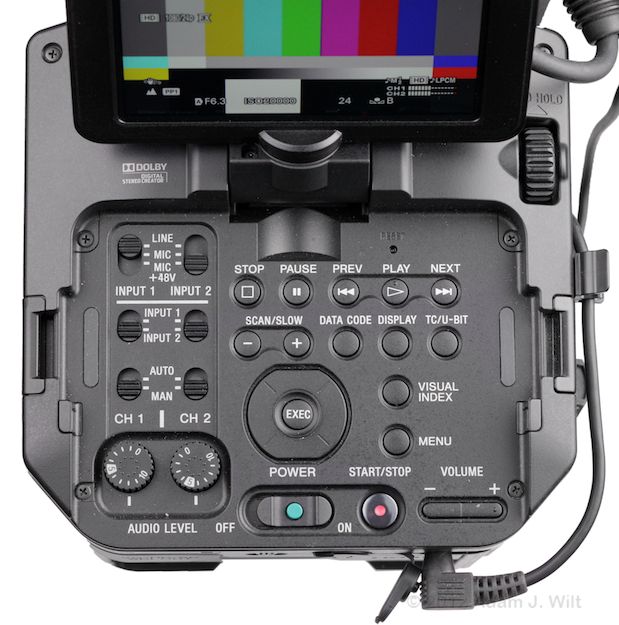
Top rear: audio, playback, and menu controls.
The rear half of the top has an inset well for the folded-down LCD; this well is chock-full of controls.
Along the left side are the usual audio controls: LINE/MIC/+48v selectors for both XLRs; input-to-channel routing switches, AUTO/MANual gain switches, and rotary controls for audio level.
Two rows of transport-control and data-display buttons fill the top right. Below that, there’s a four-way rocker for menu navigation with a center EXECute pushbutton. Two important buttons sit to its right, VISUAL INDEX and MENU. VISUAL INDEX is the button you push to toggle between “camera” and “playback” modes. MENU is a second menu button, handily placed so that if you’re involved in playback operations, you needn’t detour to the side of the camera to call up the menus.
At the rear edge, alongside the audio pots, there’s the master power switch (with a green pushbutton lock to reduce inadvertent actuation), a START/STOP trigger, and a headphone volume rocker switch. This entire row of important-while-shooting controls is accessible even with the LCD folded down.
Bottom
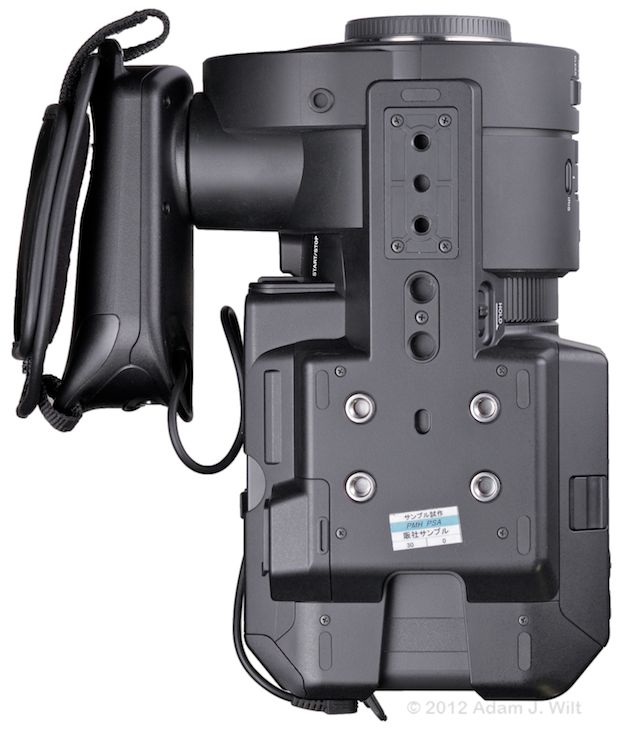
Underneath, there are two 1/4″ and six 3.8″ mounting sockets.
The camera has plenty of mounting points on its baseplate (and, unlike some of the sockets on the FS100, all of them are deep enough to accommodate almost any common tripod or baseplate screw).
Notice, at the very rear of the recorder section, the two small, oblong rubber feet. On the FS100, these served a purpose; on the FS700 with its thicker baseplate, these two feet dangle up in the air: useless appendages left behind in the evolution of the FS100 to the FS700—evidence of common ancestry, and of common parts used for both cameras!
Front
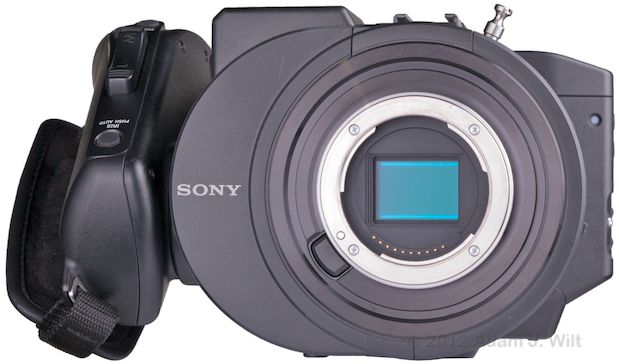
The FS700’s sensor resides behind an offset ND filter wheel.
The camera’s front is dominated by the immense offset filter wheel housing for the camera’s three ND filters, a housing not unlike that of the filters and mechanical shutter on the F65.
The lens release is on the lower left edge of the lens mount. There’s a red tally LED at the upper right corner of the recorder section.
Display
The camera’s single display is a 3.5″ (8.8cm) LCD, mounted atop the camera on a tilt-and-swivel pivot. The LCD can be spun completely around to face forwards; spun 90 degrees in the other direction to face the right side of the camera; flipped up 150 degrees for low-angle viewing, or spun around and folded flat for looking straight down at, like the groundglass on a Hasselblad. It can also be folded flat, face-down, for protection during transportation.
The LCD resolves about 400 TVl/ph horizontally, maybe 500 lines vertically (put another way, details on a resolution chart can be seen to those limits, inclusive of aliasing). It is bright, contrasty, and perfectly usable outdoors, even in direct sunlight.
EXPANDED FOCUS magnifies the LCD image 4 times or 8 times, and the magnified view can be moved around the image using the four-way rocker. Expanded focus can be used while recording. There’s also digital peaking available, in white, red, or yellow (but not green or blue), with three levels of edge sensitivity. Peaking and expanded focus can be used together. It’s fast and easy to set or check focus using these aids; the high magnification that expanded focus allows on the FS700 is of great benefit given the sensitivity of large-sensor cameras to focus errors.
The FS700 offers typically comprehensive Sony data readouts and status displays:
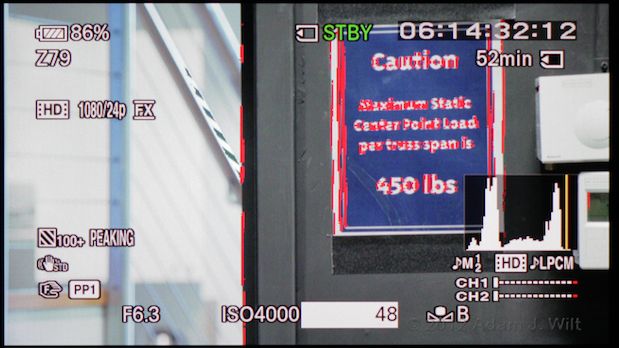
LCD with all data displays, zebra, and focus-in-red indicators. Shutter speed is selected for manual control.
With all data displays enabled, you can see battery charge in percent; record status and destination (here, it’s the SD card; it could also be the flash memory unit); timecode or user bits; zoom setting (with an E-mount lens, that is), time remaining on the current medium at the current borate; recording format; zebra setting; whether or not peaking is engaged; histogram (with a yellow line at the current peaking setting); steadyshot setting (when using a compatible optical-steady-shot lens); audio settings and levels (showing manual control of both channels); manual focusing indicator; picture profile setting; f/stop (with compatible lens), ISO or gain setting (user-selectable); shutter speed or angle; white-balance setting.
As on the FS100, the histogram shows both the superwhite area above 100% (the bit to the far right; it has a darker background, though that isn’t visible in this picture) and the current zebra setting (the yellow line). The zebra-level line remains on the histogram whether zebra is being used or not, though it can be turned off in the menus if you find it distracting. There’s only one small inconsistency; while the zebra can be set at any 5% interval from 70% to 100%, or for “100%+”, the histogram shows the 100%+ zebra setting in the same place as the 100% zebra, making the line less useful as a current-setting indicator.
While the histogram obeys the DISPLAY button, it can also be toggled independently (subject to the overall DISPLAY mode) with its own button, as can the zebra and peaking displays (by default, assignable buttons 2, 4, and 1 respectively).
With all that gumpf shown, pushing the DISPLAY button removes all the clutter from the top half of the screen (aside from the recording status), leaving only shooting-related controls visible.
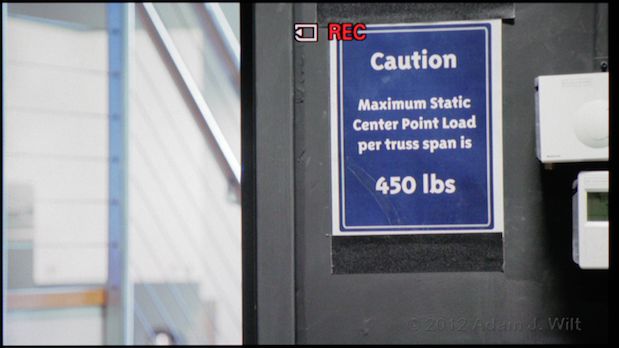
LCD with all displays off; only recording status remains.
Push the DISPLAY button again, and all overlays vanish, save for the recording status indicator.
As on the FS100, LCD markers have their own button. Markers include a center cross, a rule-of-thirds grid, and a variety of aspect-ratio (4:3, 13:9, 14:9, 15:9, 1.66:1, 1.85:1, 2.35:1) and safety-area (80%, 90%) settings. Also as on the FS100, turning on markers makes all data displays aside from timecode disappear from the video outputs, if those outputs have data displays enabled—though the markers themselves aren’t displayed on the video outputs.
The FS700 offers six pages of status display using the STATUS CHECK button, and the same style of menus as on the FS100 (see the FS100 review for samples of comparable displays—though the FS700 does not have the GPS that the FS100 does).
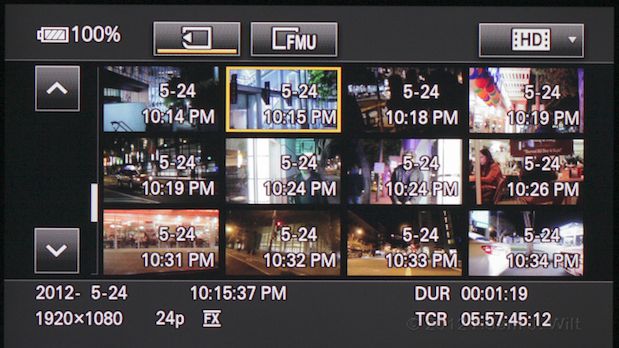
“Visual Index” mode, scrolling through clips.
Pressing VISUAL INDEX switches from camera mode to playback mode, displaying a, well, visual index of clip thumbnails. The currently-selected clip’s metadata is shown below the thumbnail array. This screen, like all the playback screens, is navigable by touch (yes, it’s a touchscreen) as well as with the four-way rocker.
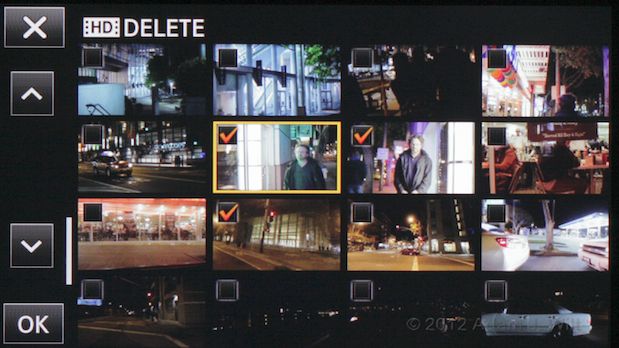
Picking clips for deletion. Note the regrettable lack of metadata display.
Unfortunately, when you tell the camera that you want to delete clips, the metadata display is sacrificed in favor of another row of thumbnails. Yes, it’s nice to see more clips without scrolling; however, you have to memorize thumbnails before switching to delete-picking mode, because there’s no way to see more info about a clip when you’re about to delete it!
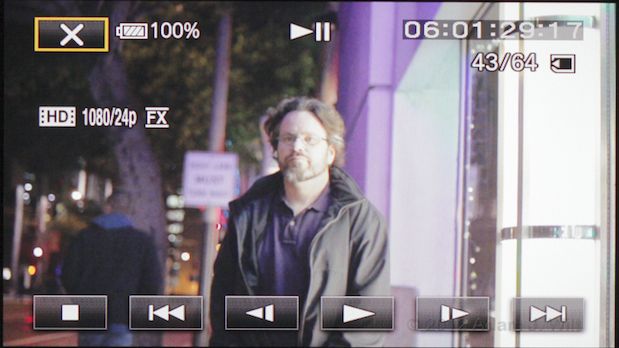
Playback mode, all onscreen (touch-sensitive) controls shown.
In playback, you get a full complement of touch-sensitive onscreen controls, as well as shooting data. In this example, I had a Nikon prime attached, so there’s no aperture, zoom, or focus readout, but if I’d used a compatible Sony lens, those readouts would appear.
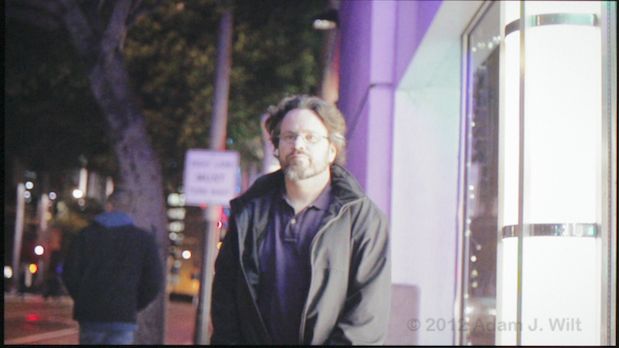
Playback screen, all controls hidden.
And again, pressing DISPLAY hides all that gumpf, leaving just the picture.
Top Handle, Mike Mount, and Handgrip
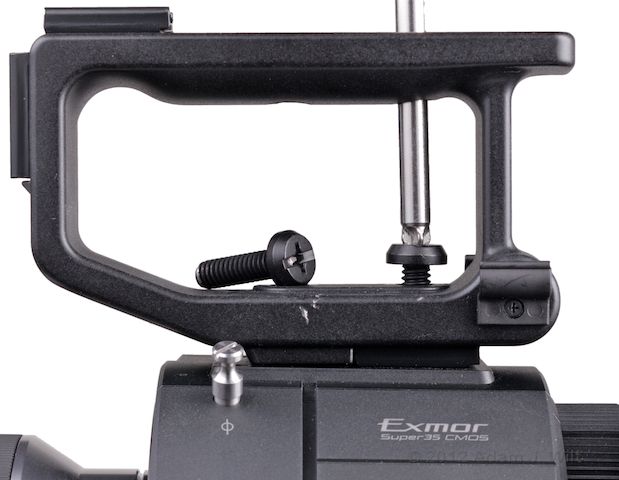
The top handle is securely attached with two long, strong screws.
The camera’s cast metal top handle slides into the camera’s accessory shoe and bolts down using two substantial screws. Once affixed in this manner, it feels like a continuation of the camera itself: it doesn’t flex or wobble in the slightest, and provides a comfortingly solid grip.
Accessory shoes on the front and top allow the mike mount to be easily attached. Cable clips on either side at the rear let the mike cable be secured out of the way.
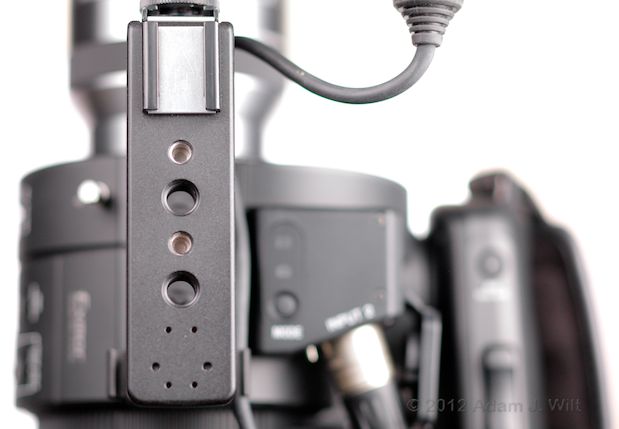
The top handle has two 3/8″ and two 1/4″ mounting sockets. Hole pattern at rear allows shoe to be relocated.
Four threaded mounting sockets allow for top-mounted accessories (like an articulated arm for a separate EVF, nudge nudge), and the top accessory shoe can be relocated to the aft end of the handle if so desired.
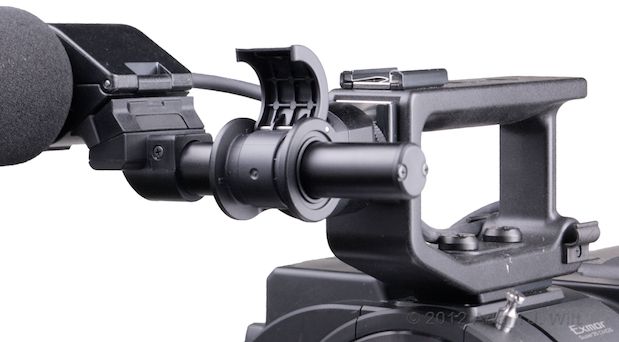
The mike mount fits in either the top or front shoe, and flips open for lateral adjustments.
The supplied ECM-XM1 electret condenser mike clips into a quick-release shockmount. The shockmount’s lateral arm can be adjusted side-to-side and rotated in place in its rubber bushing by flipping up the front of its holder; the holder itself slots into either accessory shoe (or any other standard shoe, including the one the top handle normally attaches to) and clamps in place with a knurled wheel.
The side grip has a START/STOP trigger on it, along with a zoom rocker on top (which doesn’t do anything; it’s “for future function enhancement”), PHOTO and EXPANDED FOCUS buttons at the top rear, and an IRIS PUSH AUTO button at the top front, just like the one on an ENG lens grip. The IRIS button replicates the one on the camera’s left side; it functions with E-Mount and Alpha-mount lenses with the LA-EA2 adapter.
The grip screws into a 1/4″ socket surrounded by an Arri-style rosette. The attachment screw uses a dual-winged plastic knob; on my demo camera it had been damaged, and no longer firmly held the attachment screw itself, but the rosette mount was so good at preventing rotation when the knob was even lightly tightened that I was able to quickly and easily adjust the grip and clamp it in place with minimal fuss and bother.
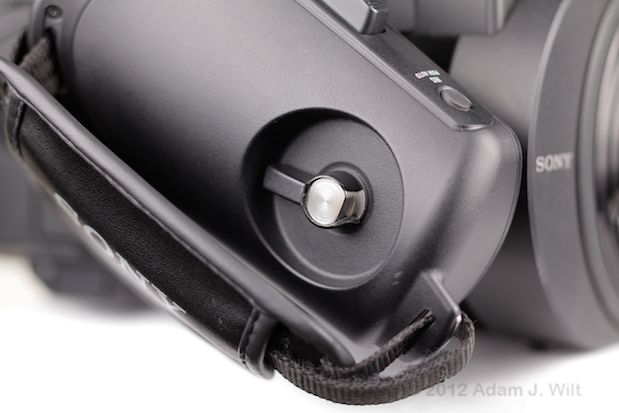
Demo camera’s side grip knob was broken, yet it still tightened securely.
Viewfinder Tube; 18-200mm lens
The viewfinder tube and 18-200mm kit lens are exactly the same as those supplied with the FS100; I’ll replicate their descriptions here, but if you want to see images, please refer to the FS100 review.
The camera is supplied with a “viewfinder tube” converting the LCD to an EVF of sorts. It clips onto the LCD with two spring clips, and extends about 7.5″ back, with an adjustable eyepiece lens and a rubber eyecup. The tube provides a big, eye-filling image, large enough to see fine detail but not so large that your eye can’t take in the whole scene for composition. It’s just slightly smaller than the scene presented by the Panasonic DMC-GH2’s EVF (one of the best EVFs available); it’s equivalent to the view of a 42″ monitor from 6 feet away.
The tube has a flip-up hinge allowing it to be opened, so that the LCD can be viewed from a distance without removing the tube. The chunk of the tube attached to the LCD acts as a hood, shielding the LCD from incident light; while the LCD itself is daylight viewable (and one of the best and brightest I’ve used in full sunlight), using the tube as a hood is helpful when shooting outdoors.
The SEL18200 zoom lens supplied with the FS700UK package is an 11:1 kit lens designed for Sony’s NEX line of compact system still cameras. It has 67mm filter threads and a “petal” style lens hood. The lens body is finished in bright, polished aluminum, with black rubber zoom and focus rings. (There’s an all-black version of the 18-200mm that’s supposed to be shipping Real Soon Now; I don’t know if that black version of the lens will be offered in an FS700 kit or not.)
The lens ranges from 18mm to 200mm; in 35mm still camera terms that’s the equivalent of 28.8mm to 320mm. In 35mm cine camera terms, well, it’s an 18-200mm zoom!
The zoom is a directly-coupled mechanical zoom; it’s most compact at 18mm, and extends considerably at 200mm, doubling the length of the lens.
It has a LOCK switch to keep it at 18mm; superzooms of this sort, carried lens-down on still cameras, have a tendency to self-extend. The zoom turns in the “wrong” direction, like the zoom on a Nikon lens; it’s the reverse of the normal direction for cine and video lenses. It has a short throw of about 90 degrees, and focal lengths are marked on the barrel in white.
The focus control is a free-spinning servo ring, with rate-sensitive gain: turn it slowly and it’ll take at least 180 degrees of travel to focus from 0.3m to infinity. Turn it quickly, and that same focal range is traversed in 90 degrees or less. The focus ring turns in the right direction, the same as cine and video lenses. The ring is entirely inoperative in autofocus mode; there’s no ability to just grab it and reset focus as many fixed-lens camcorders allow.
There are, for obvious reasons, no focal-distance markings on the lens itself, but there is a distance readout on the LCD when the lens is being manually focused, though only within three seconds of actual focusing activity. The readout is in tenths of meters out to 10m, then in whole meters.
There’s no aperture control on the lens; the body-mounted IRIS control is used instead. The lens incorporates Sony’s OSS (Optical SteadyShot), similarly controlled using the camera’s menus. This lens offers both normal and “active” SteadyShot; the latter has a more tranquilizing effect on the image, more like the strong optical stabilization in many of Canon’s camcorders.
Next: Features and Functions…
Features and Functions
Recording and Outputs
The NEX-FS700 is a “world camera” settable to either 60Hz or 50Hz recording standards.
In 60Hz mode, the camera can record 1080/60p, 1080/60i, 1080/30p, 1080/24p, and 720/60p in AVCHD, at data rates from 5-28 Mbps depending on format. It also records 480/60i (with the image captured at either 30p or 24p) using 9 Mbps MPEG2 program streams, a DVD-compatible format. All formats are 8-bit, 4:2:0, long-GOP. In 50Hz mode, it records 1080/50p, 1080/50i, 1080/25p, 720/50p, and 576/50i (SD captured as 25p) formats instead, using the same codecs and bitrates.
HDMI, SDI, and component outputs are format-selectable, showing either the native recording format or downconverting it, e.g. from 1080p to 1080i, from 1080 to 720p, or from HD to SD. Downconversion from 16:9 HD to 4:3 SD can be displayed as anamorphic squeezed, letterboxed, or center-cut.
HDMI 1.4 is used; it supports 1080/60p. The HDMI live signal is 4:2:2 uncompressed at 8 bits. Timecode can be sent out HDMI for offboard recorders. When shooting 24p, 3:2 pulldown markers are embedded in the HDMI signal so that properly-equipped HDMI recorders can extract the original 24p signal from the 60i or 60p feed.
The SDI output is 3G (3 GHz), so it also supports native output at up to 1080/60p, with 4:2:2, 8-bit sampling.
Both HDMI and SDI outputs can be set to output native frame rates, e.g., 1080/24p; progressive segmented field (PsF); or normal interlaced 60i output with pulldown.
In my testing with a Panasonic BT-LH1700W monitor and a Zacuto Z-finder EVF, all three output modes worked when in normal recording modes, but when shooting Super Slow Motion, output had to be set to 60i with pulldown for an image to be displayed. The preliminary ops manual says that 720p, 480p, and 576p outputs aren’t supported in Super Slo-Mo, but says nothing about 1080p or 1080PsF not working; I don’t know if this absence of signal was a limitation of my pre-production prototype test camera alone or if it carries across into the production models.
Data displays can be superimposed on the video feeds, or the feeds can be left clean for recording.
The camera’s single media slot can accommodate either Memory Stick or SDHC media. Video can be recorded in parallel to a card in the card slot and to the Flash Memory Unit, if installed. If one destination fills up, recording continues on the other medium. Relay recording—bouncing between the card slot and the FMU as one or the other fills up— is not supported.
Shutter Speeds and Frame Rates
In 24p, the FS700 allows shutter speeds of 3, 6, 12, 24, 40, 48, 50, 60, 96, 100, 120, 144, 192, 200, 288, 400, 576, 1200, 2400, 4800, and 10000 (where the shutter speed is the reciprocal of the number shown, e.g. “60” means 1/60 second).
In 30p, 60p, and 60i recording, the speeds are 4, 8, 15, 30, 60, 90, 100, 125, 180, 250, 350, 500, 725, 1000, 1500, 2000, 3000, 4000, 6000, and 10000.
50p, 50i, and 25p allow speeds of 3, 6, 12, 25, 50, 60, 100, 120, 150, 215, 300, 425, 600, 1000, 1250, 1750, 2500, 3500, 6000, and 10000.
Shutter speeds slower than the frame rate (or field rate) slow the image-update rate; at 1/3 second, the camera is still recording 24fps, but each frame is recorded eight times, for a 3fps apparent playback rate, complete with third-of-a-second motion blur.
Note that 24p doesn’t allow 1/30 second; if you need to avoid 60Hz lighting-induced flicker, you’ll need to shoot at 1/60. Similarly, 30p/60i speeds don’t include 1/50, useful for reducing flicker in 50Hz countries; you’d need to shoot at 1/100 instead. Having to move to faster shutters speeds affects motion rendering, but its impact on low-light capability, as we’ll see, is not the issue it would be on small-sensor cameras.
Also note that there is no Clear Scan recording on the FS700: no “fractional speeds” like 60.1, 60.2, 60.3, etc., often used to eliminate flicker from computer monitors, laptops, mobile phones, and other discontinuous displays with arbitrary refresh rates and bizarre backlight frequencies.
S&Q (Slow & Quick; variable frame rate) recording is available at the push of a button in 1080p shooting. The camera offers a selection of overcrank/undercrank speeds: 1, 2, 4, 8, 15, 30, and 60fps in 60Hz mode, or 1, 2, 3, 6, 12, 25, and 50 fps in 50Hz mode. These are full-resolution speeds utilizing the entire active area of the sensor, without windowing or line-skipping.
SSM (Super Slow Motion)
Super Slow Motion grabs video faster than the camera can record it: it captures frames to an onboard memory buffer, then (more slowly) writes the frames to your storage medium. A couple of slides from my Cine Gear Expo presentation tell the story:
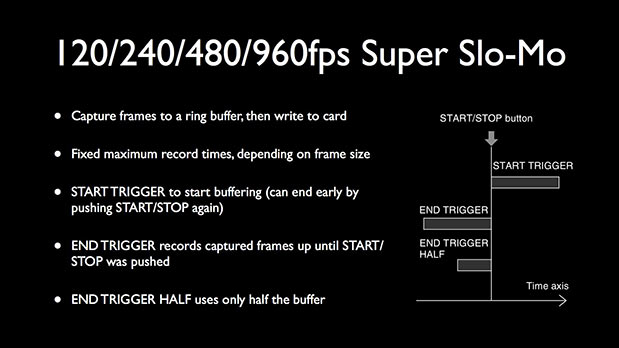
These are the 60Hz frame rates; when the camera is running at 50Hz, you’ll have the options of 100, 200, 400, and 800fps instead.
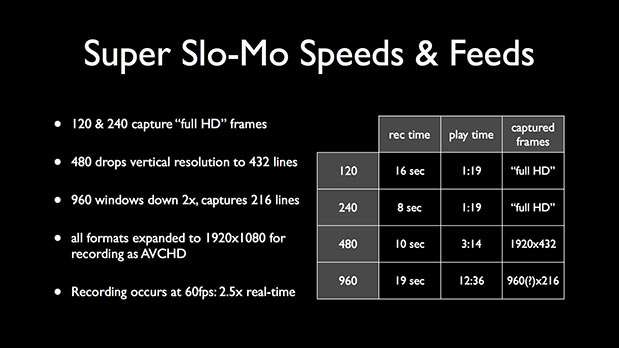
At 120 and 240fps, the camera reads the entire sensor, capturing full-res 1920×1080 frames (though with somewhat coarser demosaicing, as you can see here). The camera will grab about 16 seconds of 120fps footage or 8 seconds of 240fps footage before its buffer fills up. Both 120 and 240fps take 1 minute 19 seconds to play back at 24fps.
480fps line-skips, reading out only 432 scanlines according to Sony, because the sensor simply can’t read out its entire contents at 480fps. The frames are buffered as 1920×432 and then expanded back to 1920×1080 for AVCHD encoding and recording. The smaller size of the buffered frames allows a longer duration to be captured: 10 seconds of real time, playing back over 3 minutes 14 seconds at 24fps.
Similarly, 960fps “windows down” about two times, reading only the central quarter of the sensor’s area (and getting only 216 scanlines as a result). The 960×216 frames can be buffered for 19 seconds; expanded back to 1920×1080 and recorded, this comes to a stonking twelve and a half minutes of 24fps playback.
Yes, quality degrades at higher speeds; look at the res charts and video clips in the above-mentioned Cine Gear Expo press. 480fps is acceptable for subjects without too much fine vertical detail; the low-res, color-speckled 960fps is really a “special effect” mode—but if you need the speed, it’s there.
The recorded clips inherit the camera’s current timebase. If you had the camera set for 1080/24p, a 240fps clip will play back at 24fps, ten times slower than real time. If instead you had the camera configured for 1080/60p recording, a 240fps clip will play out at 60p, a four times slowdown instead.
To record SSM, you press the S&Q button (it can be set to trigger S&Q alone, SSM alone, or cycle through normal / S&Q / SSM modes); hold it down to highlight the current SSM frame rate and change it with the side wheel.
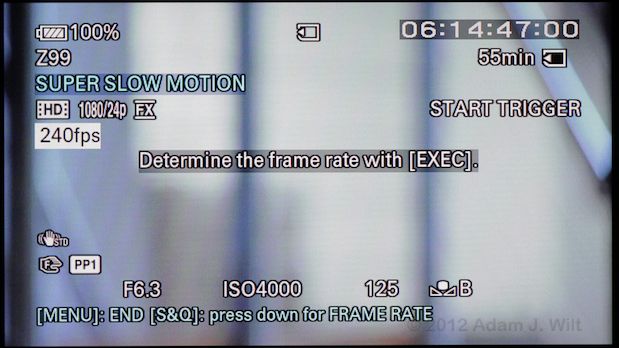
Super Slo-Mo: selecting a speed; start triggering will be used.
By default the camera uses START TRIGGERing; press the START/STOP button to start buffering slo-mo frames.
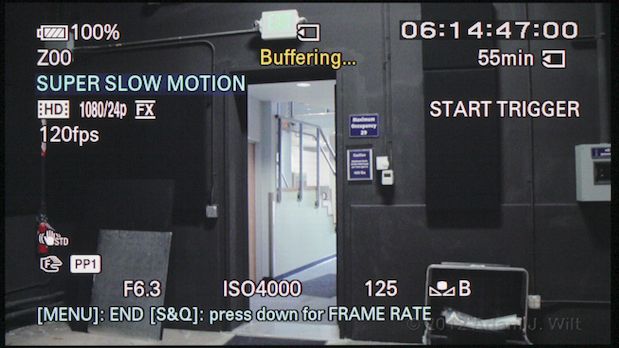
Super slo-mo: in the process of capturing at 120fps.
Buffering will stop when the buffer fills, or when you press START/STOP again to stop it.
You can also configure the camera for END TRIGGERing: the camera constantly buffers frames, overwriting the buffer as needed. When you see the action you like, press START/STOP to record the current contents of the buffer; this is a great was to grab hard-to-predict events (as long as you don’t wait too long after the event happens!). If the buffer size and resulting clip length is too much for your needs, there’s also END TRIGGER HALF mode, which simply records the most recent half-buffer’s-worth of footage.
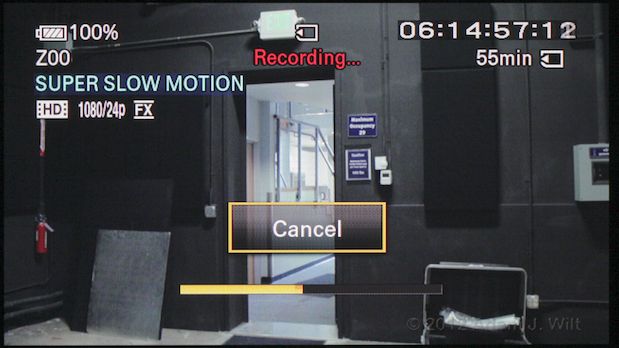
Super slo-mo: capture done; writing to SD card at 60p.
When you stop buffering, whether due to a button push or to buffer filling, the camera switches from “buffering” mode to “recording” mode. What you see onscreen is your buffered footage playing back while it’s being written to the memory card. This recording happens at about 60fps; if you had the camera set for 24p, the “playback” happens 2.5x faster than real time. For example, if you filled the buffer at 120 or 240fps, it’ll record to card in about 32 seconds, even though (at 24fps) that clip will play out for 1 minute 19 seconds. If you filled the buffer at 960fps, even recording it at 60p takes five minutes; the desirability of END TRIGGER HALF soon becomes apparent!
You can always press the CANCEL button onscreen (or the EXEC button on the top panel) to abort the recording early. The clip recorded up to that point will be preserved, and any remaining data in the buffer will be discarded.
There are a couple of exposure “gotcha”s with SSM recording: the histogram isn’t available while in SSM mode, and the shutter speeds come from the 30fps / 60fps list, not the 24fps list: 1/125, 1/250, 1/500, etc. instead of 1/120, 1/144, 1/192, 1/200, 1/288, 1/400, etc. Because of this, if you’re shooting with a 24fps timebase, you can’t look at the histogram in normal mode and then transfer that exposure info into SSM: none of your shutter speeds match. Fortunately the zebra still works in SSM; use the histogram as needed in normal mode, see where the zebras fall, switch to SSM, and then dial in the same amount of zebra to get the same exposure.
[Interesting, isn’t it? In ye olden days, a zebra would have been all we’d need for exposure. In this soft, decadent modern era, we have histograms as well… and we miss them when they aren’t available!]
Audio Recording
Audio can be captured as Dolby Digital compressed, or as linear PCM (LPCM) uncompressed. Both channels are sampled at 48Khz with 16 bits of resolution.
Audio from either input can be recorded on either channel, or on both. Mike inputs allow input trimming from +12dB to -18dB (actual levels of -60dBu to -30 dBu, with a default of -48dBu) in 6dB steps; linked or separate AGC; separate per-channel wind filters.
The headphone feed can be set to monitor channel 1 only, channel 2 only, or a stereo mix of the two.
Compared to the FS100, the relocation of XLR 2 to the top right corner of the camera (as seen from above) means that the physical layout of the XLRs more closely matches the arrangement of the channel control on the top panel; the left-for-right swap I lamented in the FS100 isn’t present on the 700 (on the 100, XLR 2 is where the FS700 has its SDI output; the XLR inputs are reversed compared to the control payout on the top panel!).
Timecode
The FS700’s timecode generator has all the usual tricks: rec run, free run, preset, regen, and the ability to put time-of-day in the user bits. There is no genlock input or capability, nor does the FS700 have a built-in GPS for a time reference.
Image Tweaks and Rendering
In addition to indoor and outdoor settings, WB PRESET can be set to WB TEMP, which can be manually adjusted anywhere from 2300K to 15000K. In this mode, pressing the camera’s white-balance button highlights the color temperature setting on the LCD and lets you dial it in directly, without having to go into the menus.
One big deal with the FS700 is that it inherits cine gammas from the XDCAM EX line of equipment. These gammas provide a film-like, S-curved highlight rolloff, instead of a sharp-edged video knee followed by a hard crash into clipping. Not only is brightness more naturally represented by cine gammas, color is too: instead of suffering dramatic hue shifts at the knee and clip points, color smoothly desaturates at high brightness levels.
If anything, cine gammas look better on the FS700 than they do on the higher-end XDCAM EX camcorders like the PMW-EX1, EX3, and F3. The S-curving sets in at a slightly higher level, so the desaturation of bright skintones is delayed. Skintones also seem to hold hue more accurately in the highlights, without that slight veering towards yellow that can sometimes occur on PMW-series cameras.
With the cine gammas, the FS700 is capable of some of the most pleasing direct-from-the-camera images available today.
The camera stores image tweaks in six customizable Picture Profiles. Along with Gammas and Color Modes, Picture Profiles allow a number of additional adjustments as well. Generally speaking, they cluster into tweaks that affect tonal scale rendering, color rendering, and image enhancement.
Tonal scale rendering adjustments start with Black Level adjustments on a scale of -15 to +15.
Three standard and four cine Gamma curves control tonal rendering. STANDARD and ITU709 are both traditional “video” gammas. STILL replicates the tonal response of Sony Alpha still cameras; it’s a snappy, high-contrast look with smoothly rolled-off highlights. The four cine gammas vary the contest balance between shadows and highlights, and all have a smooth, S-curved highlight response:







Black Gamma lets you tweak shadow rendering, almost like the inverse of a knee. Three ranges (LOW / MIDDLE / HIGH let you set the “inverse knee point” from around 20% to 50%, while an adjustment range of -7 to +7 lets you compress (-) or expand (+) the tonal scale below that point.
Knee affects highlights above a certain point. The camera selects the knee point and slope in AUTO mode, though you can set the MAX POINT of the knee from 90% to 100% and set the sensitivity to one of three levels. In MANUAL, you choose the knee point from 75-105% in 5% increments, and the slope from +5 to -5: essentially anywhere from an expansion of the tonal scale for dramatically-blown highlights, to completely flat at the knee point.
Knee only applies to the STANDARD and ITU-709 gammas, of course.
Color rendering combines a new set of matrices with the same sorts of adjustments as on the FS100 and earlier NXCAM and HDV camcorders.
Color Mode lets you choose a TYPE of color: STANDARD, STILL, CINEMA, PRO, and ITU-709:





Color Mode also offers an 8-step LEVEL control varying the effect of the chosen matrix, with 1 being close to the STANDARD matrix and 8 being the full-on Color Mode matrix.
Color Level varies saturation from -8 to +7, with -8 being monochrome and +7 being about twice as saturated as normal. Color Phase spins the color rendering around on the vectorscope, like an NTSC tint control.
Color Depth is a unique Sony feature; it’s a sort of six-way color corrector that lets you vary the brightness signal based on color. Each of the six colors—red, green, blue, cyan, magenta, and yellow—has a “color depth” from -7 to +7; negative numbers brighten the color by lifting R, G, and B values equally, while positive numbers decrease R, G, and B equally, with a total range of about 10%. The effect is that the darkened colors gain saturation or “depth” while the lightened colors become paler.
White Balance Shift lets you offset the camera’s white balance not only on the warmer-to-cooler (amber-to-blue) axis, but in tint as well: the green-to-magenta axis. You can use cinematographer’s controls (LB-CC mode: “Color Temp” to vary blue-to-amber and “CC” to vary green-to-magenta) or colorist / video-shader controls (RB mode: Red gain and Blue gain, with Green gain fixed), depending on your background and preferences. Either mode yields similar results: the ability to properly shift white balance in any direction. It’s extremely helpful in tweaking out color biases; I only wish the PMW-EX1 had similarly comprehensive white balance control.
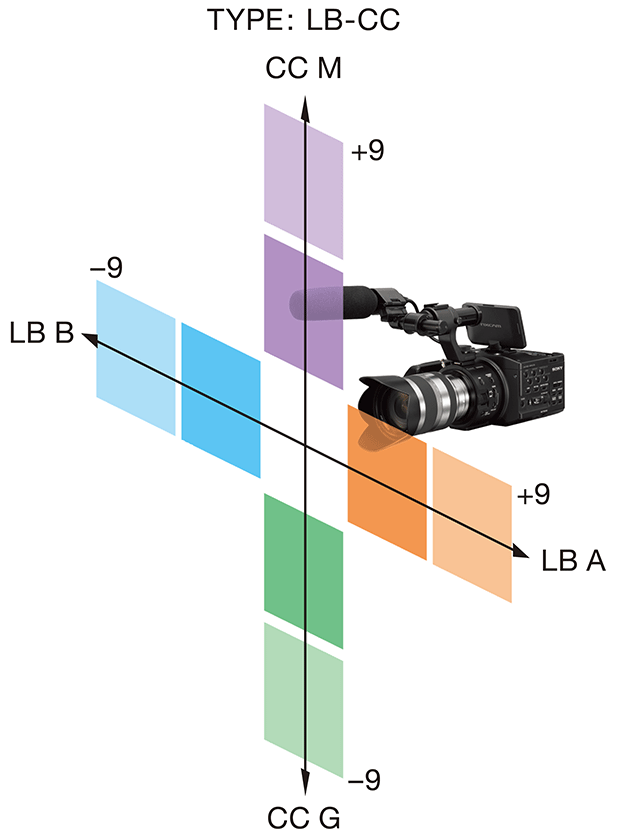
Like the FS100 shown, the FS700 gives you two ways to tweak white balance; LB-CC will feel natural to cinematographers. Graphic courtesy of and copyright by Sony Electronics.
Image enhancement: Picture Detail is adjustable from -7 to +7. -7 appears to be detail off, while +7 is noticeable but not objectionable. The creation of the detail signal is controlled automatically by default; if you don’t like what the camera does, you can opt for manual control instead: you can vary the horizontal/vertical detail balance; limit the level of the added detail signal (thus allowing small detail changes to be emphasized while not causing cartoonishly exaggerated outlines on stronger contrasts); adjust black vs. white outlining balance, adjust crispening (the minimum level of inter-pixel change needed to trigger enhancement; useful for suppressing noise emphasis); and limit detail application in highlight areas (to prevent things like black-outlined ceiling lighting fixtures).
Most of the detail adjustments are fairly subtle and unobtrusive. The default levels on the FS700 were entirely pleasing to my eye, even when pixel-peeping; for the most part I left detail on full auto at its default level, and I was never unhappy with the result.
4K in the Future?
Sony claims that a future firmware upgrade may allow the output of “compressed 4K raw” on the 3G SDI port, recording to an as-yet-unannounced Sony recorder. As the sensor is said to be “4K Ready” (see next page), this is not beyond the realm of possibility—but delivery dates, prices, and limitations haven’t been discussed.
Next: Performance…
Performance
The FS100 uses a single “Super35mm” CMOS sensor with a color filter array; it’s 24.2 mm x 14.8 mm overall. It is said to be “4K Ready”, meaning that it has enough photosites for a 4096×2160 native image. A 16×9 “4K HD” or “quad HD” image of 3840×2160 resolution totals 8,294,400 pixels; Sony says the FS700 uses “approximately 8,300,000 pixels” in creating its 16×9 image, which is close enough (the sensor has about 11,600,000 pixels or photosites overall). This high pixel count means that the camera should have more than enough oversampling to render a very crisp, sharp HD image at the limits of what 1920×1080 can show: up to 1080 TVl/ph in both H and V directions.
Image Rendering and Resolution
Surprisingly, the FS700 is very close to the FS100 on the charts, capturing 800 TVl/ph horizontally and 1000+ lines vertically, as you can see in the Cine Gear Expo writeup at the bottom of page 1 and the top of page 2 (look at the normal, 24fps charts). There’s also some slight horizontal luma aliasing, and muted vertical chroma aliasing.
It’s clear that the camera’s internal demosaicing isn’t getting quite as much out of the 4K-ready sensor as theory says it should; it’s not bad, but it’s not as crisp and detailed as one might hope. In real-world shooting, though, the slight resolution shortfall isn’t an issue; FS700 pix look very rich and detailed.
Even so, if and when the 4K compressed raw output becomes available, it’ll be interesting to see what additional quality can be wrung out of this sensor.
Going into Super Slow Motion, as we’ve already seem, decreases the image quality slightly, leading to more visible aliasing and moir©. It’s detectable but not distracting at 120 and 240fps; tolerable at 480fps; and, well, sub-SD-quality at 960fps, for reasons already discussed.
Sensitivity
The early prototype FS700 I shot “Pacific” and “Fire & Ice” with had a base sensitivity of ISO 500 at 0 dB gain, the same basic sensitivity as the FS100. At 30dB gain, ISO was 16,000.
The pre-production FS700 I tested for this article (and that Art Adams shot the Betabrand Food Fight with) had a base ISO of 640, 1/3 stop faster, and a 30dB gain sensitivity of ISO 20,000. I observe that the Canon C300’s sensitivity range is also ISO 640 – ISO 20,000. I’m not saying that the FS700’s analog gains got tweaked a third of a stop just to be competitive, but I do find the tweak to be interesting, grin.
Yes, noise increases as ISO increases, but as on the FS100 even very high gains are quite watchable. I won’t presume to say what the “highest usable gain” is because different folks have wildly different tolerances for image noise or “grain”. At ISO 20,000, “grain” is noticeable, but it’s a filmlike, isomorphic noise pattern, balanced between luma and chroma noise.
Shooting Super Slo-Mo’s top two frame rates also causes increases in noise and chroma artifacts, since the line-skipping readout used means that single pixels (and their noise) are being stretched vertically to fill in the missing scanlines.
Dynamic Range
I did some DR testing with my 13.3-stop Stouffer wedge, but all I managed to do was see that I has 12+ stops in all gammas, because (a) it’s hard to distinguish a third of a stop in the shadows, and so discern precisely where there isn’t anything more to be seen, and (b) it looked like there was some exposure in even the darkest parts of the wedge, compared to the surrounding areas.
Then Art Adams brought over a DSC Labs Xyla-21 chart, which offers 20 stops of dynamic range. Here’s a shot of the Xyla shot with the FS700, in Cine Gamma 4; each step on the Xyla is one stop, and I pulled a frame where the brightest step had just fully clipped:

FS700 shoots Xyla-21: black level lifted a bit and gamma stretched in post.
I count 14 stops of dynamic range, with perhaps 11 of them being “paycheck stops”. Crikey!
[Art Adams defines the terms paycheck stops and gravy stops. Paycheck stops are those you have to capture, “otherwise your paycheck stops”. Any stops beyond those are gravy stops.]
The other gammas may lose as much as one stop of total range (oh, the horror of having a mere 13 stops!), and the contrastier ones may “only” have about 9 paycheck stops; overall, this camera does a great job of capturing as much of the tonal scale as possible and making it available through the cine gammas’ S-curved compression or the video gammas’ knee functions. Art has a full writeup on the FS700’s dynamic range.
Oh, yeah: the image is taken from an 8-bit AVCHD clip, recorded internally. No fancy-schmancy 10- or 12-bit extended-range external recorders or nothin’, just plain old 8-bit, highly-compressed AVCHD.
I, personally, do not find this displeasing.
Sensor Artifacts
The FS700 is quite similar to the FS100 in this regard, with a clean and naturalistic image… as long as you don’t overexpose. Sharp transitions between normal exposure and overexposure—edges of blown-out windows, sharply-defined specular highlights, and the like—show jagged, oversharpened edges and spurious chroma artifacts. I’m guessing that when a cluster of photosites is sampled and processed to generate an image pixel, having some but not all of the photosites in the cluster driven to their clipping values may be fooling the color-reconstruction algorithm used, just as channel-specific clipping in the highlights (on any camera) can cause a hue shift in the affected area.
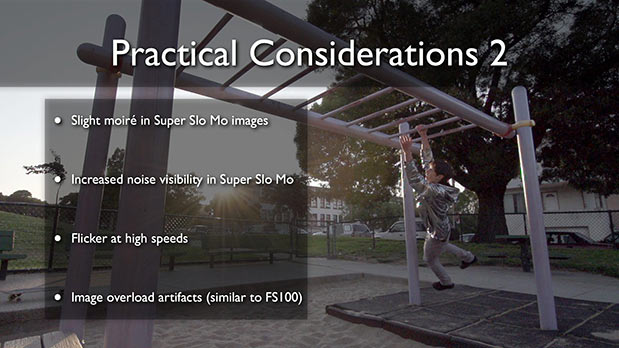
Image artifacts, from the Cine Gear preso: a typical frame with bright highlights…
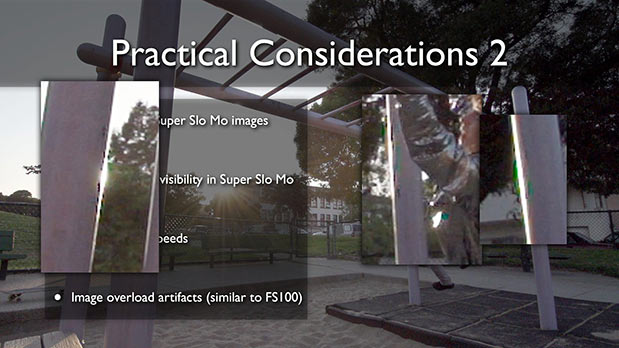
…zooming in on areas where decoding artifacts are visible.
Normally, the false-color artifacts are about two pixels wide or high (the minimum size visible using 4:2:0 recording), and fairly unnoticeable unless you’re actively looking for them. For the most part this seems to be an issue on vertical or nearly-vertical edges; horizontal edges don’t appear to cause the same degree of artifacting.
Especially given the similarity to the FS100, I expect these artifacts are generated by the FS700’s demosaicing engine. It’ll be interesting to see if they go away if/when we can get raw data out of the camera and decode it at leisure, without the pressures and limitations of real-time recording.
In other aspects the sensor is very well-behaved. It’s CMOS, so there’s no vertical smear. There is rolling shutter, but the top-to-bottom readout time is about 1/60 second in normal recording, so it’s in the same league as other high-quality CMOS camcorders. Super Slo Mo modes had readout times sufficient to clear their frames: on the order of 1/120 sec @ 120fps, 1/240 sec @240fps, 1/480 sec @ 480fps, and 1/960 sec @ 960fps. Fixed-pattern noise wasn’t visible, even at the highest of gains.
Recording
The camera can use either Memory Stick PRO Duo or SD/SDHC/SDXC media. Class 4 SD cards are required for normal recording, class 10 for S&Q and SSM recording (or PRO-HG Duo Memory Sticks). Alternatively (or in parallel) Sony’s HXR-FMU128 Flash Memory Unit can be fitted on the right-hand side of the camcorder, offering up to 11 hours (!) of continuous 24 Mbps recording.
The camera records HD as AVCHD, a long-GOP, 8-bit, 4:2:0 format with a variety of bit rates. The settings are labeled FX, FH, HQ, and LP, which run from 24 Mbps (max; average is 21 Mbps) down to 5 Mbps average. All record excellent-looking still-lifes, but when the camera or the scene moves, the lower the bitrate, the faster the image turns into blocky mush. With FX looking about as good as XDCAM EX HQ while consuming only 24 Mbps, there’s rarely a need to select a lower-quality bitrate unless storage space is highly constrained.
The FS700 also offers a 28 Mbps (max data rate) format, called “PS”. It is only used when shooting 1080/60p. Looking at still frames, I found the resulting image quality to be roughly on a par with 1080/24p shot in “FH” mode (17 Mbps); in my spasmodic shakycam tests I was able to generate more visible long-GOP compression artifacts in PS mode than in FX. However, bear in mind that 1080/60p has rather a lot more frames per second than 1080/24p, so that any error is onscreen only 40% as long in PS as in FX. It all evens out: while single-framing shows more visible artifacts in PS than in FX, in normal 1x playback, PS-mode 1080/60p spasmodic shakycam looked just as good as FX-mode 1080/24p spasmodic shakycam… only a lot smoother due to the higher frame rate.
Overall, I’d rate recording quality on the FS700 (as on other current-model camcorders recording 24 Mbps AVCHD) as being perfectly fine for WYSIWYG imaging: it looks clean during normal playback, with scarcely any visible compression artifacts. Minor post-processing, such as gentle white-balance corrections or subtle tonal-scale adjustments, is usually possible without revealing the limitations of the format.
Those looking to process the image heavily in post, whether through aggressive color correction, keying, motion tracking, and/or slo-mo, will obviously find it less accommodating than a picture with lower compression, less chroma subsampling, and a higher bit depth.
SD is recorded as 9 Mbps MPEG-2 Program Steam, again at 8 bits with 4:2:0 subsampling. It’s a DVD-compatible bitstream, which offer great convenience (and freedom from recompression) for all those FS700 owners dumping their camera-original SD clips straight to DVD. For the rest of us, well, DV recording would have been more postproduction-friendly, but with FX-mode HD taking up less bandwidth than SD DV, I suspect most FS700 shooters will leave the camera in HD at all times,
Audio
Audio quality is very good overall, and the built-in limiters (which you can switch on or off at your pleasure) keep loud transients from clipping—I don’t think I ever saw the meters hit the ceiling with the limiters on, despite feeding obscenely loud sounds into the mike.
The wind filters (low-cut filters) are essential when using the supplied mike on-camera, as low-frequency handling noise carries through the handle and shockmount at the slightest provocation. With the wind filter, such noises are merely annoying instead of completely overwhelming. Using a separate mike mount with better isolation helps, too, as does moving the mike entirely off-camera.
The FS700 offers the choice of Dolby Digital (AC-3) compressed recording, or LPCM uncompressed. Both are sampled at 16 bits, 48 kHz. Both sound clean and natural, though Linear PCM may be a bit more “open” and “spacious”.
Power
The stock battery, an NP-F770, is supposed to run the camera about five hours; the larger F970 is rated for 8.5 hours. I used both the F770 and F970s, and the stated numbers appear to be accurate. While the F770 sits well recessed in the battery compartment, the F970 fill it out flush with the back of the camera (images for this article were shot with an F960 battery, the same size as the F970).
Super Slo-Mo seems to knock about 20% off the battery life. Even so, with two batteries you can shoot all day.
The camera doesn’t report the estimated remaining running time, but it does show a charge-remaining percentage in the display, so it’s easy to keep track of the rate of depletion and avoid sudden power-loss surprises.
The FS700 comes a battery charger and a separate AC adapter that plugs into the camera on the lower right side, so you can run off AC while charging the battery. The AC adapter’s camera-side cable is long enough to let the adapter lie flat on the ground while the camera is mounted at eye level on a tripod.
Optics
Optics on the NEX-FS700 are what you make of them, which is why I left this for last (and, for the most part, this is copied from my FS100 review, so if you’ve read that, skip this!).
The basic FS700U package is lensless; you use whatever E-mount lens you want; use a Sony LA-EA2 adapter for Sony’s A-mount lenses; or use any of a variety of third-party adapters for Nikon, Canon, PL-mount, or other lenses. With an 18mm flange depth, E-mount cameras offer plenty of flexibility in mounting almost any interchangeable lens available, through appropriate adapters.
If you were to opt for the FS700UK package, you would wind up with the SEL18200 18-200mm f/3.5-f6.3 Optical SteadyShot zoom. It’s an $800 “superzoom kit lens” designed primarily for the NEX line of still cameras; adding it to the FS700 kit costs an additional $600 (list price).
The 18-200mm kit zoom is about four inches long at 18mm, but it doubles in length as it’s zoomed in: if you want to use a matte box, it had better be a clip-on. The filter threads are 67mm, and the front of the lens does not rotate as it’s focused. It’s very light for an 11:1 zoom: 18.5 ounces (524 g).
The lens is an adequate if not stellar performer. At 18mm, there’s noticeable barrel distortion; it straightens out by around 30mm, with slight pincushioning appearing by 50mm and persisting out past 100mm, straightening out again at 200mm. At 200mm there’s maybe a pixel of green/magenta lateral chromatic aberration. Zoom out to 100mm or wider and it’s pretty much gone.
Sharpness is quite good throughout the range, though the images overall aren’t quite as crisp, contrasty, and “snappy” as the same scenes imaged with higher-end lenses—a comparison possible due to the FS100’s E-Mount. A Sony Alpha-mount SAL2470Z 2-70mm f/2.8 Zeiss and a Nikon 17-55mm f/2.8 both gave me crisper renderings of the same scenes, but the former lens lists for $1800 while the latter is a mere snip at $1540 (those lenses are bigger and heavier, too, and their 3:1 zoom ranges don’t match the 11:1 of the kit lens; they’re not better choices necessarily, just different in their tradeoffs).
Zoom aside, it’s a servo-driven lens; focus tracking and aperture are electronically controlled. Both iris size and focus groups need to adjust as the lens is zoomed, and in such operations the 18-200’s still-camera origins become clear. The focus blurs slightly even during fairly slow zooms, while any zoom of four seconds end-to-end or faster shows visible exposure changes as the iris motor struggles to keep up (zooming in causes darkening during the zoom, while going wider makes the picture momentarily brighter). These sorts of servo-lag issues aren’t a problem while reframing still images, but they limit what you can do with the zoom while shooting motion.
I’ve already mentioned the uncalibrated, free-spinning, rate-sensitive focus ring. Of equal concern for the motion shooter is the lens’s relatively small maximum aperture, which starts off at f/3.5 with the lens zoomed out and ramps to f/6.3 as the lens zooms in. From an exposure standpoint this is less problematic than it looks; the camera’s extremely clean images allow for lots of gain boost without visible image impairments (I shot quite a bit in auto-gain mode without worrying about “grain” changes in the shot; it was very liberating to be able to do so!).
From a depth-of-field standpoint, these small max apertures won’t allow for the sorts of shallow-focus shots you might want from a large-single-sensor camera. If you plan to use shallow focus to isolate foreground elements in a “cinematic” way, you will—sooner or later—wind up with one or more wider-aperture primes or zooms in your kit (trust me on this: it was documenting an Art Adams Canon 5D Mk II shoot with a roughly-Super35mm-sensor-sized Nikon D300 and its 18-200mm f/3.5-f/5.6 superzoom that made me crave wider apertures and shallower focus. That led to the aforementioned 17-55mm f/2.8, then a 12-24mm f/4, some fast primes, the 70-200mm f/2.8… it’s a $ad, $ad $tory, and one that you, once equipped with a large-sensor interchangeable-lens camera, will quite simply be unable to resist. You have been warned).
Overall, it’s a very nice kit-lens superzoom for a still camera, though it shows its limitations for motion work. Even so, you shouldn’t dismiss it out of hand: it’s inexpensive, lightweight, and covers a substantial zoom range. It performs quite well as a versatile, variable prime, especially in circumstances where extreme wide-aperture depth of field isn’t required: wide shots, landscapes, tight telephoto work, and the like.
Next: Handling and Operation; Conclusion…
Handling and Operation
Like the FS100, the FS700 doesn’t even pretend that the “Handycam” form factor is suitable for large-single sensor cameras. Instead, it’s designed as a “block” or “brick” camera suitable for tripod or Steadicam use. Handheld operators will find the brick and its side-mounted handgrip usable for short periods with small and light lenses, but if handheld is your game you’ll want to add a separate EVF and relocate the grip for more balanced operations.
On a tripod, the FS700 is perfectly at home. Its large, flat base and multiple tripod sockets allow a firm, stable mount. The LCD monitor can be swiveled to either side, spun completely around, and/or folded flat, allowing very flexible operation; the viewfinder tube can be useful in bright light to eliminate glare.
The operational controls and buttons are sensibly laid out; if there’s any criticism possible, it’s that they’re a bit small, a bit close together, and a bit too similar in feel to be readily differentiated by touch—though in fairness, making them larger or spacing them farther apart would require a larger camera body.
Handheld, the camera is less tractable, at least without accessorization. You can certainly use it like an old box Brownie, or a medium-format still camera, wrapping your hands around the blocky body and peering down into its LCD, but that’s not a very common operating method. The camera cries out for a separate EVF mounted off the forward left side; I added a Zacuto Z-finder EVF on an articulated arm and found the package much more handholdable right off the bat.
The handgrip is orientable at any angle, but it’s stuck so far off to the side that holding the camera level with anything but the lightest of lenses is problematic. Still, it’s usable for short periods in this configuration.
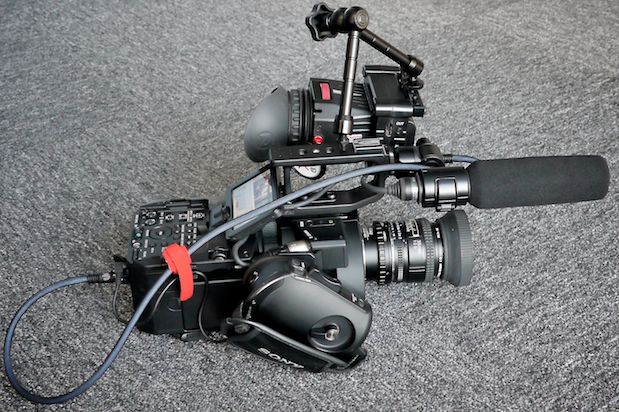
Minimal handheld rig: Zacuto Z-finder EVF, Nikkor 35mm prime.
Even so, the grip is too far rearward and too far off to the side for really stable work. Moving the handgrip forward, down, and inward allows the back end of the camera to rest on your shoulder, with the right hand on the grip lifting and supporting the camera, and the left hand free to focus and zoom the lens.
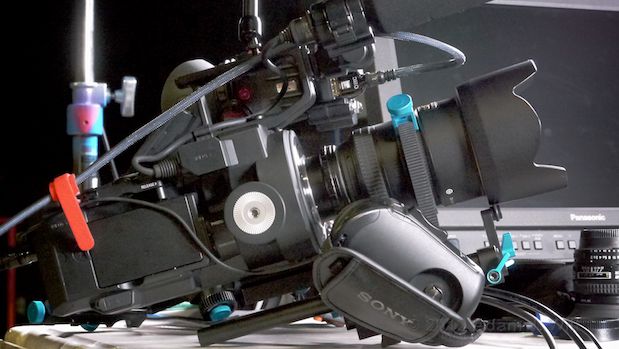
Handheld rig 2: Zacuto EVF, Nikkor 17-55mm, side grip relocated to 15mm rods using a Shooting Machines Stub Clamp.
Fortunately the grip’s LANC cable is long enough to allow this sort of relocation, and moving the grip in this way completely transforms the camera. It’s no longer an awkward, side-heavy monster, but a stable, shoulder-braced shooter. While it’s not quite in the Alexa or Aaton league, it’s not bad at all. (We just need a rosette-equipped 15mm rod clamp so that the grip can be locked in place as easily as it can on the side of the camera; accessory makers, are you listening?)
“Why not put the FS700 on a full-fat shoulder-mount rig”, you ask? Why not, indeed; the camera is quite suitable for that sort of work. I touch on it briefly in the companion article on third-party accessories for the FS100; the rig makers I discuss therein are actively working on build-up kits for the FS700.
The grip’s EXPANDED FOCUS button came in handy while shooting; it was easy to trigger—and, thankfully, it works even while recording. Expanded focus can be set for 4x, 8x, or both magnifications in sequence, and the expanded area can be moved around on the screen in case your subject isn’t dead-center. The zoom rocker is completely ignored by the camera.
The IRIS button is helpful with E-mount lenses (and Alpha-mount lenses, presumably; I didn’t have such lenses available during my testing), but is worse than useless when using incompatible lenses: pressing the IRIS button (which is quite easy to do) causes a view-blocking error message to appear:
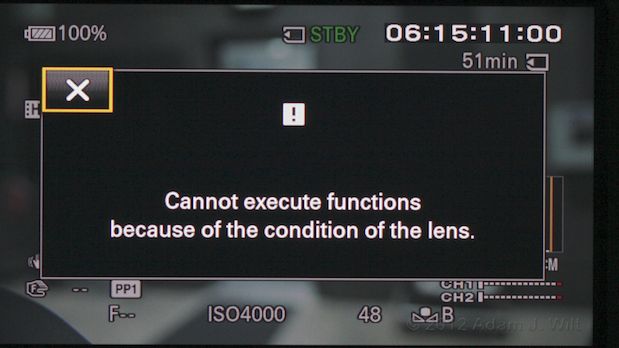
Whenever I hit the IRIS button on the side grip by mistake, this message blocked the screen for four seconds!
This opaque message box pops up, and left to its own devices it’ll sit onscreen for what seems like an eternity, though in fact it’s only four seconds. If you have your wits about you, you can dismiss it with a tap on the touchscreen LCD or a press of the EXEC button, but neither control is normally right beneath your fingertip while shooting.
But I found that my wits weren’t about me whenever this message appeared; my reaction was to panic utterly: where’s my bloody picture gone??? Now, I’ve calmly driven a car at highway speeds when the windshield was suddenly covered by a sheet of foamcore blown off the truck in front of me; landed a small plane when the runway ahead vanished in a burst of rain just at the roundout and flare; flown the pattern and landed smoothly when a crankshaft seal failed just after takeoff and coated the plane’s windscreen with oil. Loss of forward visibility doesn’t normally bother me much, apparently, which makes my panic at this scary-looking error all the more interesting. In those other situations, of course, there was merely a sudden and unexpected life-safety issue; here, I could no longer see what I was shooting! It completely freaked me out, all out of proportion to the seriousness of the problem.
I really wish the FS700 had a menu setting to disable this message!
All my comments about the viewfinder tube in the FS100 review apply to the FS700’s viewfinder tube: it’s handy in bright sunlight, but it’s long and heavy, stressing the LCD’s mount. It puts the eyepiece well aft of the camera, so that it moves around a lot during panning and tilting. It also prevents use of the touchscreen.
The camera takes ten seconds to power up, four seconds to switch to Visual Index (playback) mode, and three seconds to switch back to camera mode. Once in the desired mode, the camera is instantly responsive.
The only other notable delay is that incurred while shooting Super Slo-Mo: after recording a buffered clip to memory, there’s a wait of a couple of seconds between the time the “recording” indicators vanish and the screen goes live again. When Art Adams and I were on location with director Ian McCamey for the Betabrand spot, Ian would often call for action as soon as the “recording” status disappeared, and Art had to restrain him until the camera started showing a live picture.
There appears to be a slight indeterminacy in record triggering; Art noticed that sometimes the start of a slo-mo clip wasn’t recorded at the very instant he pressed the START/STOP trigger. It wasn’t worse than, say, half a second, but when you’re looking at a maximum recording duration of 8 seconds (at 240fps), every half-second becomes significant. This same start delay isn’t noticeable in normal recording, but that may simply be that we aren’t as concerned with precise clip-start timing in normal shooting. I didn’t have the opportunity to characterize this delay more precisely.
I didn’t test the camera’s FACE DETECTION autofocus mode, nor did I have a chance to use the LA-EA2 Alpha lens adapter. The camera can also shoot stills, but I didn’t explore this.
It’s worth noting that HDMI and SDI outputs are available simultaneously, something that some far more expensive cameras cannot do.
Conclusions
The NEX-FS700 is a worthy descendant of the FS100, adding ND filters, Super Slo-Mo, cine gammas, and SDI output to the large-single-sensor camera.
A multitude of mounting points makes it easy to build the camera into rigs and to add cheese plates for additional attachments.
The camera’s E-mount offers access to a small but growing collection of E-mount lenses, and it allows adapters for almost any other lens available, from Sony’s own Alpha-mount lenses to Nikon, Canon, PL (cine), M (Leica), and other glass.
The top-mounted LCD serves admirably when using the camera on sticks, but its position is less than optimal for shoulder-mount rigs or eye-level handheld work, and its add-on viewfinder tube is too long and too awkward for most situations. The serious FS700 shooter will want to add a second, more repositionable viewfinder, such as the Cineroid, Zacuto, Kinoptic, or Alphatron EVFs.
Beyond the simple fact that it uses a Super35mm-sized-sensor, the camera has many desirable features, such as six picture profiles, 1080/60p capability, S&Q motion (undercrank and overcrank, all the way to 60fps at full resolution), SSM (slo-mo to 240fps at full res and 480 and 960fps at reduced quality), 14 freakin’ stops of dynamic range, gorgeous colorimetry and film-like cine gammas, and high-ISO performance all the way to ISO 20,000.
It also has some odd omissions, like no Clear Scan and no 1/30 sec shutter speed at 24fps for flicker and rolling-shutter banding reduction.
Image quality is very good, bar the occasional false-color and edging artifacts on edges of overexposed highlights. These are reduced compared to the FS100’s imaging quirks, but they’re still noticeable on occasion.
A Super35mm sensor; 1080p resolution (if slightly soft); variable frame rates from 1fps to 960fps; adaptability to almost any lens available; stunning low-light performance; solid-state recording on affordable media (and up to 11 hours with the HXR-FMU128); runs half a day on the stock battery; cine gammas: there’s a lot to recommend this camera. On the flip side, there are awkward aspects to the unusual design, some limitations in image processing and shutter speeds, telltale artifacts of an imperfectly-interpreted color filter array sensor, and the need for a third-party EVF.
One could argue that the Canon C300 or RED Scarlet offer better-looking images (I’ll discuss those arguments in a later article), but those cameras cost twice as much. PMW-F3? It has S-Log and 10-bit 4:4:4 capability, but cine gammas give much of the quality of S-Log without requiring viewing LUTs, and actually exploiting the F3’s 10 bits and/or 4:4:4 requires a pricey external recorder on top of the $14,000 (street) price of the camera itself. FS100? It’s still a fine camera for $5000, but the FS700’s cine gammas make it a much better image maker, and the addition of NDs, SDI, and Super Slo-Mo tip the balance in favor of the FS700.
The bottom line? I think the NEX-FS700 is arguably the best value for money currently available in large-single-sensor camcorders, due as much to its cine gammas and overall image quality as to its inclusion of Super Slo-Mo. Just be sure to budget for a separate EVF if you want to go handheld, and for an offboard SDI or HDMI recorder if you need better than AVCHD quality.
Pros
-
- Best large-single-sensor image quality available under $14,000.
-
- Super35mm-sized sensor.
-
- Interchangeable lenses.
-
- E-mount allows adapters for almost any other lens on the planet.
-
- 1080/24p, 1080/60p, 1080/60i, 720p, 480p, and 480i formats (60Hz mode); “Worldcam” flexibility with corresponding 50Hz formats.
-
- SSM (120 / 240 / 480 / 960fps) super slow motion recording.
-
- S&Q (1-60fps variable frame rate) recording.
-
- Compact and lightweight.
-
- Lots of threaded attachment points; highly customizable.
-
- Six tweakable scene files, complete with cine gammas.
-
- Good design for tripod / Steadicam work, with swiveling top-mounted LCD.
-
- 14 stops of dynamic range!
-
- Excellent low noise, low-light performance; ISO 640-20,000.
-
- Large LCD with good focusing aids and comprehensive status displays.
-
- SDI and HDMI simultaneously available, with configurable output formats.
-
- HDMI data includes pulldown-removal flags for offboard recorders.
-
- Records on either SDHC or Memory Stick media.
-
- Works with the HXR-FMU128 Flash Memory Unit for extended record times.
-
- Clean 24 Mbps AVCHD recording (28 Mbps in 1080/60p) with LPCM audio option.
-
- Three ND filters built in, despite the shallow 18mm flange depth.
Cons
-
- Clip-on viewfinder tube is long and awkward.
-
- LCD ill-positioned for eye-level handheld or shoulder-mounted work.
-
- False color / edging artifacts on clipped, contrasty edges.
-
- Picture not quite as sharp and detailed as sensor specs allow.
-
- No 1/30 shutter at 24fps (for 60Hz lighting flicker / banding reduction).
-
- No Clear Scan (finely-variable shutter speeds for shooting monitors).
-
- Side grip is too far off-center for comfortable handholding.
-
- Terrifying error message blocks view when IRIS button is pushed with an incompatible lens mounted.
Cautions
-
- E-mount provides access to a wide variety of stills and cine lenses through readily-available adapters; with a camera this flexible, you’ll be tempted to exchange all your worldly possessions for a nice collection of glittery glass.
-
- Sony talks about a 4K compressed raw output in the future, but don’t make a buying decision today based on undelivered features with an unspecified timeframe. On the other hand, folks bought REDs and seem to be happy. So make up your own mind, grin.
See Also:
My Cine Gear preso on the FS700
Art Adams’ Cine Gear preso on FS700’s dynamic range
Shooting FS700 Slo-mo: “Pacific”
Testing the NEX-FS700 at Meets The Eye
Art Adams: Lighting Fire and Liquids: Playtime with the Sony FS700
Art Adams: Food Fights with the FS700
Art Adams: 240fps Promo Goes Live Thanks to Sony FS700
Art Adams: Avoiding the Big Gotcha When Shooting High Speed at Night
Quick Look: Three New E-Mount Primes
Quick Look: Alpha A-mount Lenses on the FS100 (mostly applicable to the FS700)
Third-Party Accessories for the FS100 (a good primer for accessorizing the FS700)
Disclosure: Sony shipped me a pre-production NEX-FS700UK for review at their own expense, following their earlier shipment of a prototype NEX-FS700. The camera was returned to Sony just prior to Cine Gear Expo.
Hot Rod Cameras sent along a Tuner-S kit (PL mount adapter and baseplate), which I used for my studio slo-mo tests (“Fire & Ice”), and Shooting Machine lent me the Stub Clamp I used for attach the handgrip to the 15mm rods. All these accessories have been or will be returned to their makers.
Additionally, I purchased an “EzFoto Rail System Follow focus FF + 15mm Rod Rig Base Plate with Quick Release plate” for $300 from Amazon, and a refurbished Zacuto Z-Finder EVF Snap and accessories directly from Zacuto for $574.34, along with a couple of articulating arms from Amazon and FilmTools; all these bits ‘n’ pieces helped me evaluate the FS700 more fully and equip it for real-world shooting. This money was spent out of pocket and the full price was paid for all items.
No material connection exists between me and Sony or any of the accessory vendors mentioned in the article. No one has offered any payments, freebies, or other blandishments in return for a mention or a favorable review.

Filmtools
Filmmakers go-to destination for pre-production, production & post production equipment!
Shop Now